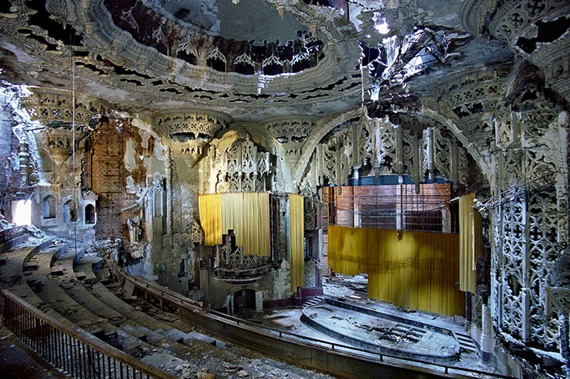Ruins
February 06, 2011 ・ Blog

Ruins are fetishes. Ancient structures are romantic, no matter how mundane their previous functions. Modern ruins are poignant, laced with reminders of impermanence and folly. And for all this they’re powerful.
Hitler and his architect, Albert Speer, who he’d had employed to design the third Reich’s triumphal city, were fascinated by the idea of ‘ruin value’. Inspired by the picturesque weathering of Roman structures, they wanted to create structures which would still proudly stand a 1000 years on. As writer Lee Sandlin says in his essay Losing The War:
“Arches or pediments or rows of pillars could be reinforced far beyond the requirements of the load they would carry, so that they would still be standing after the rest of the structure was dust - ensuring that even the wreckage of the Reich would inspire awe.”
Fast forwarding and inverting this idea, we have Detroit, once the model of American might, which has become a fetishised ruin. Witness photographs like these, taken by Yves Marchand and Romain Meffre. They seem to depict the incredible - newly dead buildings, left to rot by a society that’s had to leave them behind - often seemingly in a hurry.
What they make, though, is denounced by locals, according to John Patrick Leary in his essay Detroitism, as ‘ruin porn’. Among various attitudes Leary identifies reportage about Detroit having to its subject, he focuses on ‘Detroit lament’: “mournful in tone - elegiac at best and sanctimonious at worst.” It’s a depiction of a city that emphasises emptiness, and in doing, edits out the fact that people still live here.
Leary calls Julien Temple’s 2010 documentary on the city, Requiem for Detroit?, quintessential Detroit Lament, and locals clearly don’t like his attitude. A small Facebook group called for the film to be boycotted, quoting his Guardian article to promote the film:
“Approaching the derelict shell of downtown Detroit, we see full-grown trees sprouting from the tops of deserted skyscrapers. In their shadows, the glazed eyes of the street zombies slide into view, stumbling in front of the car. Our excitement at driving into what feels like a man-made hurricane Katrina is matched only by sheer disbelief that what was once the fourth-largest city in the U.S. could actually be in the process of disappearing from the face of the earth.”
Zombies. But this really isn’t Dawn Of The Dead: Detroit is still a living city, a point that seems inconceivable in photographs which look like they’re torn from lurid post-apocalyptic films. The Facebook group’s description continues:
“Yes, Detroit has problems, indeed major problems, but the city is far from this post-apocalyptic wasteland described by the writer. I do not support this project and suggests that the writer revisits and engages with citizens for a realistic depiction of our city.”
And that’s exactly the point - you won’t find reality in ruins, only fictions that were written both when they were built and when they fell.